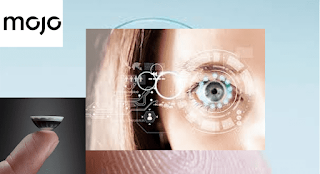The Revolution in Contact Lenses for Augmented Reality
With gene therapy, shape-shifting robots, virtual reality, and now
augmented reality, the world is full of possibilities. Twenty years ago, the
idea that we could merge the real world with computer-generated information or
that we would be able to operate computers with only a contact lens would have
seemed absurd. This is what augmented reality entails. Augmented reality, or
simply AR, is the process of fusing the physical and digital worlds to produce
something wholly unique and thrilling. With the use of holographic technology,
we may use the virtual to engage with the physical environment by enhancing the
actual world with digital material.
Consider this: whereas virtual reality aims to completely recreate
reality in a digital setting, augmented reality (AR) aims to enhance our view
of the real world by incorporating computer-generated visuals, video, music,
and other elements. It's like giving our brains a brand-new perspective on
reality.
So how does it function? Based on their mathematical relationship,
virtual 3D graphics can overlay actual world objects inside any device that
generates AR content. The combined image is displayed on mobile screens, AR
glasses, and other devices like contact lenses, therefore the device must be
able to determine the location and orientation of objects in relation to one
another.
Speaking of AR contact lenses, these will be the focus of this text, but
first, let's establish the historical context of how augmented reality was
created.
A quick history lesson:
Ivan Sutherland, regarded as the inventor of computer graphics, and Bob
Sproull created the first AR technology at Harvard in 1968. Sutherland and
Sproull developed an augmented reality (AR) head-mounted display system to
overlay virtual data over the real world. This was referred to as "The
Sword of Damocles," and it was punk rock-inspired awesome. Over the years,
businesses, academic institutions, research facilities, and government
organizations have advanced this technology. The first commercial AR application
wasn't created until 2008, though. German advertising firms in Munich designed
a printed magazine ad for a BMW Mini that, when placed in front of a camera,
displayed on the computer screen. Users could operate and observe the virtual
car from various perspectives by moving the paper. One of the earliest
marketing initiatives that enable real-time communication with a digital model
was this one.
The most important advancement in augmented reality (AR) technology was
made available a few years later in the form of a tiny contact lens.
Meet Mojo Vision:
"We're building Mojo Lens, which is, in our opinion, the first
augmented reality smart contact lens," says Mojo Vision. A contact lens
created by the American startup Mojo Vision puts an augmented reality display directly
before your eyes. You can now receive notifications and information without
having to look at your phone or tablet, that's correct. Furthermore, you can
operate the display solely by moving your eyes. Imagine it as a spotlight that
moves together with your eyes. Over $100 million has already been invested in
the development of this ground-breaking invention, which has been under
development for the last ten years.
The contact lens incorporates specialized microelectronics that were
custom-built for it and the densest microdisplay in the world, with a
resolution of 14,000 pixels per inch. With 14,000 pixels per inch of density,
the micro LED display inside the lens is the smallest and most dense in the
world. It is ideal for social and professional settings because the lens is
discrete and does not alter your appearance.
Even more, the Mojo Vision contact lens is internet-connected, allowing
you to instantly access information based on your surroundings. It might be
able to direct you to the closest grocery store or gym, for instance.
Additionally, the business has been given permission by the American Food and
Drug Administration (FDA) to test the contact lens on people who have vision
abnormalities including macular degeneration or retinitis pigmentosa.
Applications and Possibilities:
Mojo Vision sees business applications for professionals that require
real-time information in their field of vision without cumbersome headsets.
Without diverting their attention from the task at hand, picture a surgeon
viewing a patient's vital signs in real time or an engineer viewing
difficult-to-access components inside a machine. For firefighters, the lenses
might even show oxygen levels, enhancing the efficiency and safety of their
work.
That's not all, though. A version of the lenses for the general public
is being developed by Mojo. Imagine not having to reach for your phone to
access translations, weather updates, and location information. It's like
having a personal assistant or invisible computer right before your eyes. There
are countless options.
Ironically, we've moved from avoiding sitting too near to the television
to putting it right in front of our eyes. Science is incredible.
Roadblocks and Challenges to Come:
The AR contact lenses by Mojo Vision are a promising advancement in the
field of wearable technology. This is the stuff of science fiction fantasies.
There is still much work to be done. Before they can be sold, these lenses must
pass a few regulatory requirements because they are still in the development
stage. Although the lenses have received FDA approval, there are still concerns
about how they would effect the eyes, whether there was a burn danger (because
it is still an electrical device), and how they would affect people who have
impaired vision. These queries and worries are being addressed by Mojo Vision
as they develop their technology.
We still have a few more years until we start using these contact lenses
on a regular basis. The three main aspects that will influence when and how AR
contact lenses become a reality for consumers are technology, medical approval,
and market value. However, the future of augmented reality seems tremendously
exciting as businesses like Mojo Vision continue to push the envelope of what
is possible. Prepare to bid adieu to those cumbersome headgear and welcome the
Mojo Vision contact lens, which puts the augmented reality world in front of
your eyes.


